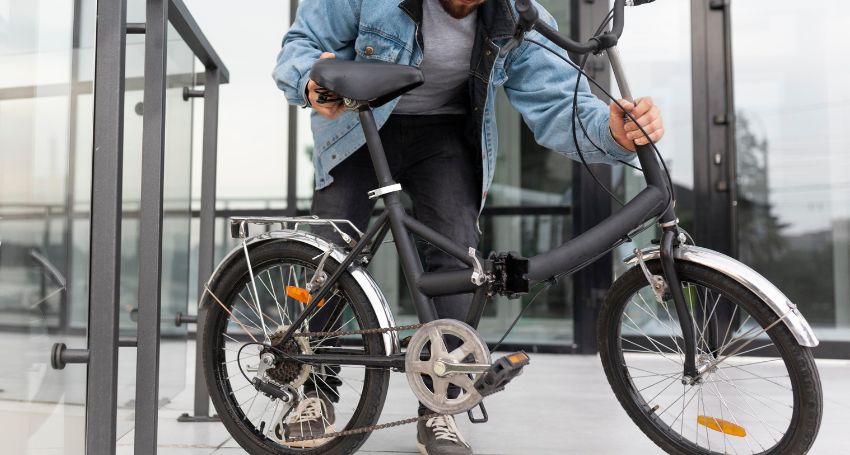
Understanding eBike Sustainability
eBike sustainability is a crucial concept in the realm of environmental conservation and efficient energy usage. eBikes, or electric bikes, are a form of transportation that merges the physical activity of cycling with the assistance of an electric motor. This combination results in a mode of transportation that requires less energy than conventional motor vehicles, thus contributing to the sustainability of the environment. eBikes’ design focuses on energy efficiency. They utilize a small electric motor to aid in pedaling, powered by a rechargeable battery. This battery can often be charged using renewable energy sources, further enhancing the environmental impact of eBikes. The energy consumption of an eBike is considerably lower than that of a car or motorcycle, making it a more sustainable option. The production of eBikes also takes into consideration sustainability principles. It involves fewer resources and results in less pollution than the manufacture of larger vehicles. Moreover, eBikes have a lower environmental impact than traditional bicycles, as they make cycling more accessible and appealing, potentially replacing more polluting forms of transportation.
What makes eBikes a sustainable means of transport?
eBikes’ sustainability as a means of transport is primarily due to their low energy consumption, minimal environmental impact, and potential to replace more polluting vehicles. The electric motor in an eBike uses a fraction of the energy required by a car or motorcycle, reducing the demand for fossil fuels and the associated carbon emissions. The environmental impact of eBikes is minimal. The production of eBikes requires fewer resources and generates less waste than larger vehicles. Moreover, the battery life of an eBike can be extended through proper care and maintenance, reducing the need for replacement parts and further minimizing environmental impact. The potential for eBikes to replace more polluting forms of transport also contributes to their sustainability. By making cycling more accessible and appealing, eBikes can encourage people to switch from cars or public transportation, reducing traffic congestion and air pollution.
How does eBike usage contribute to sustainable urban traffic changes?
eBike usage can significantly contribute to sustainable urban traffic changes. By reducing the number of cars on the road, eBikes can help alleviate traffic congestion. This not only improves the efficiency of urban transportation networks, but also reduces the amount of air and noise pollution generated by traffic. eBikes promote a shift towards active transportation, which involves physical activity as part of the transport process. This can have significant health benefits for individuals, as well as reducing the societal costs associated with sedentary lifestyles. Lastly, the increased use of eBikes can contribute to a reduction in carbon emissions. As eBikes are powered by electricity, they do not emit greenhouse gases during operation. By replacing car trips with eBike rides, individuals can significantly reduce their carbon footprint, contributing to the broader goal of mitigating climate change.
eBikes and Their Carbon Footprint
eBikes, electric vehicles gaining popularity in the transportation sector, have a notable environmental impact. These sustainable modes of transportation are lauded for their energy efficiency and their relatively low carbon footprint. The carbon footprint of a product or activity refers to the total quantity of greenhouse gases produced, and in the case of eBikes, this includes the emissions from the production, utilization, and end-of-life recycling of the bike and its components. While eBikes do have a slightly higher carbon footprint than traditional bicycles due to the production of their electric components, particularly the battery, they still contribute significantly less to greenhouse gas emissions than motor vehicles. The battery life of an eBike is a critical factor in its environmental impact. The extraction and processing of lithium, cobalt, and other materials used in batteries can be energy-intensive and result in significant greenhouse gas emissions.

What is the carbon footprint of an eBike compared to a conventional bicycle?
Compared to conventional bicycles, eBikes do emit more greenhouse gases during production due to their electric components. However, the emissions associated with the use of eBikes are virtually zero, as they utilize electricity, a form of renewable energy, rather than fossil fuels. In comparison, conventional bicycles, while not requiring any energy to operate and thus having a virtually zero carbon footprint, do not offer the same level of energy efficiency. The carbon footprint of an eBike can be further reduced by ensuring the electricity used to charge it is sourced from renewable energy. Moreover, the overall environmental impact of an eBike is also significantly influenced by the lifespan of the bike and its components. Regular maintenance and proper recycling of batteries can extend the battery life of an eBike and reduce its overall carbon footprint.
After how many miles have the CO2 emissions for the production of an eBike been amortized?
The mileage at which the CO2 emissions from the production of an eBike are offset by its use depends on several factors, including the specific model of the eBike, the energy mix used to charge it, and the mode of transportation it is replacing. Research suggests that on average, the emissions from the production of an eBike can be offset after around 1,000 to 2,000 miles of use, assuming the eBike is replacing car trips. If the eBike is used in place of public transportation or walking, the distance required to offset the production emissions would be greater. However, given the longevity and energy efficiency of most eBikes, it’s likely that the majority of eBike owners will reach this break-even point during the lifespan of their bike.

eBike Batteries and Their Environmental Impact
Electric bikes, commonly referred to as eBikes, are a key player in the transportation sector’s shift towards renewable energy. These electric vehicles are powered by lithium-ion batteries, contributing to their energy efficiency and offering a sustainable alternative to traditional modes of transportation. However, the environmental impact of these batteries, particularly concerning their disposal and recycling, poses a significant challenge. The production of eBike batteries involves the extraction of lithium, a process that can potentially lead to soil degradation and water contamination, thus impacting sustainability. The disposal of these batteries, if not managed correctly, can lead to the release of hazardous materials into the environment. Moreover, the energy consumed in the production and recycling of these batteries can add to the carbon footprint. Despite these challenges, proper recycling and disposal practices can significantly mitigate the environmental impact of eBike batteries. Regulations and initiatives have been implemented in various countries to promote environmentally friendly recycling of eBike batteries, thus contributing to conservation efforts and reducing the overall carbon footprint of these electric vehicles.
How are eBike batteries recycled?
The recycling process of eBike batteries, a crucial aspect of their lifecycle, is complex and requires specialized expertise. The process begins with the collection of these batteries, either through designated drop-off points at retailers or special collection events. Once collected, these batteries are then transported to a recycling facility. At the recycling facility, the batteries undergo sorting and disassembly. The lithium-ion cells are separated from the rest of the battery components and processed to extract valuable materials such as lithium, cobalt, and nickel. These extracted materials are then utilized in the production of new batteries or other products, contributing to the overall energy efficiency of the process. The remaining components of the battery, including plastic and metal casings, are also recycled. These materials can be melted down and repurposed for the production of new products. Through the recycling of eBike batteries, the demand for new raw materials is reduced, contributing to resource conservation and overall sustainability.
Is the production of lithium for eBike batteries sustainable?
The sustainability of lithium production for eBike batteries is a subject of ongoing debate. Lithium, an abundant element extracted from sources such as hard rock mines and brine pools, can potentially serve as a sustainable resource for battery production, contributing to the renewable energy sector. However, the extraction process can have significant environmental impacts. Mining operations can cause soil degradation and water contamination, and the extraction from brine pools requires substantial water resources, which can deplete local water supplies. Efforts are underway to enhance the sustainability of lithium production. These include the development of new extraction technologies that consume less water and produce less waste. Additionally, research into alternative battery technologies that could reduce or eliminate the need for lithium is ongoing. These efforts hold promise for making lithium production more sustainable, thereby reducing the environmental impact of eBike batteries and contributing to the overall energy efficiency of electric vehicles.
Future of eBikes in Promoting Sustainability
eBikes are leading the charge in promoting sustainability in the transportation sector. The environmental impact of these electric vehicles is significantly lower than conventional modes of transportation. Powered by renewable energy, eBikes reduce dependence on fossil fuels, contributing to a decrease in carbon emissions. This energy efficiency is a key factor in their potential for promoting sustainability. Manufacturing practices for eBikes are also aligned with sustainability. The use of renewable energy sources and recyclable materials in the production of eBikes is becoming more common. The battery life of these electric vehicles also contributes to their sustainability. eBikes generally have a longer lifespan than traditional bikes, reducing waste and further minimizing their environmental impact. eBikes are playing an increasingly important role in sustainable urban planning. As cities strive to reduce traffic congestion and improve public transportation, eBikes offer an effective solution. eBike sharing programs are being implemented in urban areas as part of a broader strategy to promote sustainable mobility. These initiatives not only reduce the number of cars on the road but also promote active transportation, further reducing carbon footprint and promoting sustainability.

How can eBikes improve public health and air quality?
eBikes contribute to improved public health and air quality in several ways. Firstly, they promote physical activity. While eBikes do provide electric assistance, riders still need to pedal. This encourages cardiovascular health and contributes to improved overall health. Regular use of these electric vehicles can lead to weight management, improved lung function, and a reduced risk of chronic diseases. Secondly, eBikes can improve air quality. Unlike cars and motorcycles, eBikes do not emit harmful pollutants. By replacing short car trips with eBike rides, individuals can significantly reduce their carbon footprint. This results in cleaner air, particularly in urban areas where air pollution is a major concern. Furthermore, eBikes contribute to reduced noise pollution. As electric vehicles, eBikes are significantly quieter than cars. This contributes to quieter urban environments, which can have a positive impact on mental health, reducing stress and improving quality of life.
What is the potential long-term environmental benefit of eBike popularity?
The potential long-term environmental benefits of eBike popularity are significant. A key benefit is the reduction in greenhouse gas emissions. As eBikes replace car trips, the amount of carbon dioxide and other harmful pollutants released into the atmosphere decreases. This could have a substantial impact on efforts to mitigate climate change. The widespread use of eBikes could also lead to a decrease in the demand for fossil fuels. This would not only reduce carbon emissions but also lessen the environmental damage caused by oil extraction and transportation. The popularity of eBikes could also contribute to less traffic congestion and a reduction in the need for large parking lots. This could lead to more green spaces in urban areas, contributing to biodiversity and improving the quality of life for city dwellers. In conclusion, eBikes have the potential to play a crucial role in creating a sustainable future.



